
Introduction: When Ctrl+Alt+Delete Didn’t Work
On Tuesday night, August 20, 2025, Pakistan collectively entered a state of shock: the internet died. Not slow, not glitchy—dead. From Karachi’s chai dhabas to Lahore’s cafes, Islamabad’s offices to Peshawar’s hostels, millions stared at their screens, refreshing in vain. Netflix stopped buffering, freelancers cried silent tears over Fiverr deadlines, and teenagers were forced into the ultimate horror—talking to their parents.
According to NetBlocks, Pakistan’s connectivity has risen to just 20% of normal traffic, a drop so steep it could make the stock market jealous. The blackout lasted hours, leaving businesses paralysed, memes delayed, and online payments frozen mid-swipe.
So, what actually happened? Let’s dive in (don’t worry, unlike our cables, this won’t break halfway).
The Technical Breakdown: When PTCL Sneezes, Everyone Gets the Flu
PTCL Backbone Failure
Think of PTCL as the “one charger” in a desi household. Everyone—Jazz, Zong, Telenor, Nayatel—borrows from it. Now imagine that the charger sparks out. Yep, that’s exactly what happened when PTCL’s upstream provider hiccupped, cutting Pakistan’s connection to the outside world.
Submarine Cable Landing Station Drama: Not Finding Nemo
Rumours flew that Karachi’s submarine cable landing station in Clifton had an issue. No, nobody cut wires under the sea with scissors—it was a hub-level glitch. But since multiple cables meet at that station, even a “minor” problem created a nationwide “major” problem.
Domino Effect: ISPs in Freefall
Since almost every telecom rents bandwidth from PTCL, the outage spread faster than a TikTok trend. Local networks worked fine, but without international gateways, it was like having a car without fuel—nice to look at, but not going anywhere.
Impact: Life Without Wi-Fi
Businesses and Freelancers
Online stores froze, call centres went silent, and freelancers missed deadlines. Considering Pakistan has 1.5 million freelancers earning $400 million a year, a few hours of downtime meant a financial hit that could’ve bought us… Well, at least a few thousand UPS batteries.
Banking Blackout
- Mobile apps? Down.
- ATMs? Error.
- Online shopping? Payment failed.
It was like being transported back to 1999, except without the Y2K panic—just pure frustration.
Social Media Detox (Forced)
WhatsApp calls dropped, Zoom classes vanished, Instagram scrolling stopped mid-reel. Families suddenly rediscovered the art of conversation. Students prayed for longer outages (no classes), while parents prayed for the opposite.
Public Services
Yango, InDrive, food deliveries, and even hospital systems felt the burn. The country got a glimpse of what “apocalypse” might look like—minus zombies, plus boredom.
Economic Fallout: Counting the Bill
Experts say the outage may have cost billions of rupees in lost productivity and stalled payments. For a struggling economy, this was like missing the only bus home after a long day.
Worse, it dented Pakistan’s image internationally. Investors already wary of power shortages now have to factor in internet blackouts too. As one analyst put it: “No serious digital economy can run if the entire country can vanish offline overnight.”
Déjà Vu: Haven’t We Seen This Before?
Yes. Same date—August 20—back in 2022, when floods damaged fibre routes. It’s almost like August 20 is cursed. Maybe next year, we should all just log off in advance and call it a holiday: “National No-Internet Day.”
The Response: PTCL and Government PR Mode
PTCL quickly tweeted (from some lucky corner of working Wi-Fi) an apology: “We’re working on it.” Hours later, service was restored. The IT Minister promised investigations and transparency—though most users said, “Can we just get backup systems instead of backup speeches?”
Lessons: How Not to Break the Internet (Again)
- Stop Putting All Eggs in PTCL’s Basket – diversify international gateways.
- Build More Landing Stations – Karachi can’t be the only one. Spread to Gwadar, Pasni, wherever there’s water and space.
- Create Local Internet Exchange Points (IXPs) – so local data doesn’t take a round trip to Singapore before reaching your neighbour.
- Protect Freelancers and SMEs – maybe digital downtime insurance? Or at least free internet “compensation data bundles.”
- Better Transparency – real-time dashboards instead of rumour-driven panic.
Global Comparison: How Others Avoid Embarrassment
India, Singapore, Malaysia—multiple cables, distributed IXPs, public monitoring. They treat the internet like electricity—essential, not optional. Pakistan could… You know, take notes.
Public Reaction: Memes > Outrage
Despite being offline, pockets of VPN warriors still managed to flood Twitter/X with #InternetDown and #PakistanBlackout. Memes rolled in:
- “I finally talked to my family. Nice people.”
- “Day 1 without internet: went outside. The graphics are amazing.”
Conclusion: The Wake-Up Call We Can’t Snooze
The August 20 outage wasn’t just a temporary headache—it was a warning. If Pakistan wants to become a digital hub, it can’t afford to go offline every time PTCL catches a cold.
The fixes aren’t rocket science: diversify, decentralise, build redundancies, and be transparent. Until then, one thing’s for sure—every heavy rain, glitch, or upstream sneeze risks sending us back into the dark ages of No Wi-Fi.